What’s The Deal With Pickup Polarity?
Imagine this heartbreaking scenario: you just purchased a Bridge pickup for your guitar. You’re excited to throw it in and rock out, so you get it installed and plug it […]


There are many ways to wire up a tone pot, and it can be confusing deciding which one to choose. Different eras of wiring produce different tones, as Modern wiring sounds different from ’50s wiring.
We’ve wired up tone pots on our best-selling Telecaster Control Plates and Prewired Pickguards in many different ways. Today, we’re only going to focus on bridging the Tone Pot off of the Volume Pot, like a Telecaster® or Les Paul® (We’ll come back to the Stratocaster soon). Here’s a list of a few different Master Tone Pot variations, with easy-to-follow diagrams:
As a refresher, a Tone Pot is nothing more than a regular pot with a Tone Cap soldered to it! The Tone Cap acts as a “high-cut” or “treble-cut” filter that only lets high frequencies pass through. The opposite leg of the Tone Cap connects to ground. So, the Tone Cap sends your high frequencies to the “trash bin” when you start turning your tone knob.
The value of your Tone Cap determines how many high frequencies get sent to the trash bin. Higher values allow more highs to ground, where lower values only skim the very top of your signal. Learn more about Tone Caps here:
Standard or modern wiring comes equipped on most guitars. It’s the most common wiring you’ll see installed on most modern production guitars and basses. See below for a few variations on the standard wiring:
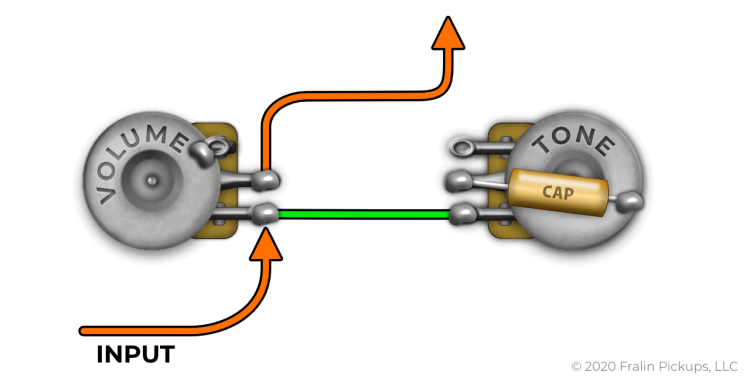
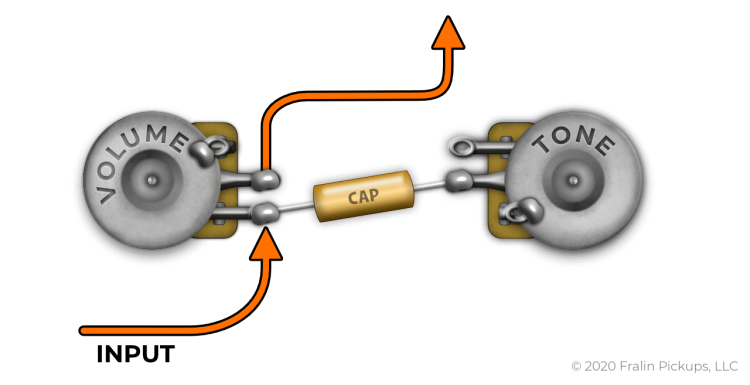
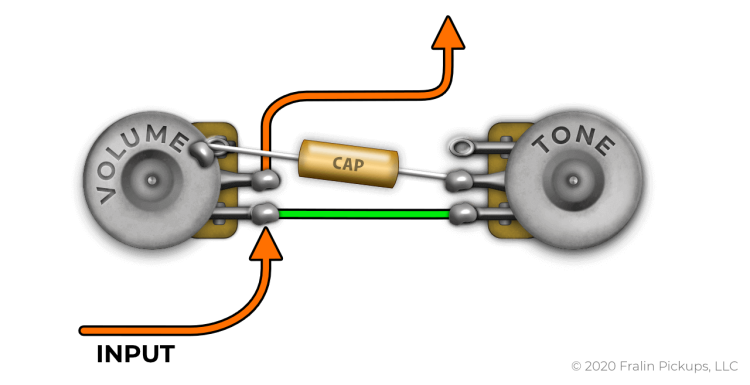
As mentioned in our ’50s Wiring Article, wiring your tone cap in the ’50s style can keep your high frequencies consistent on your pickups while turning down your volume. However, turning down your Tone can affect your guitar’s volume. See below for a few variations on ’50s Wiring:
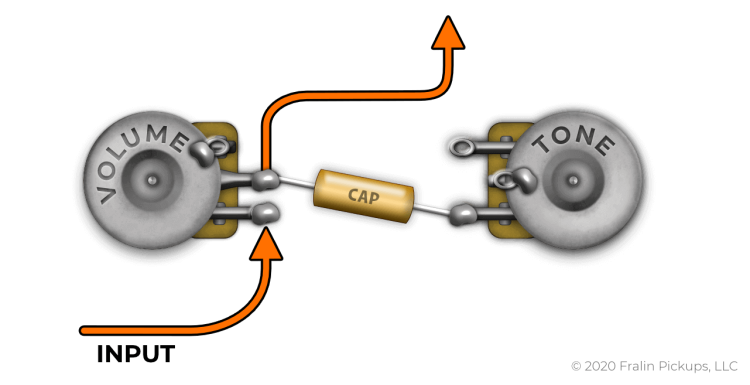
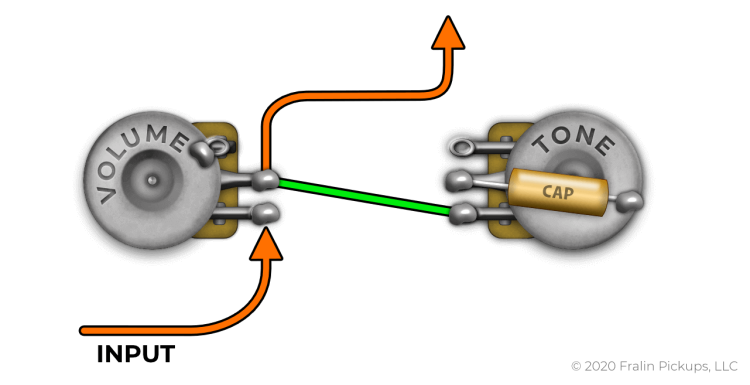
’60s wiring is almost identical to Modern Wiring, except one can expect a lesser signal to noise ratio. Here’s how to wire it up:
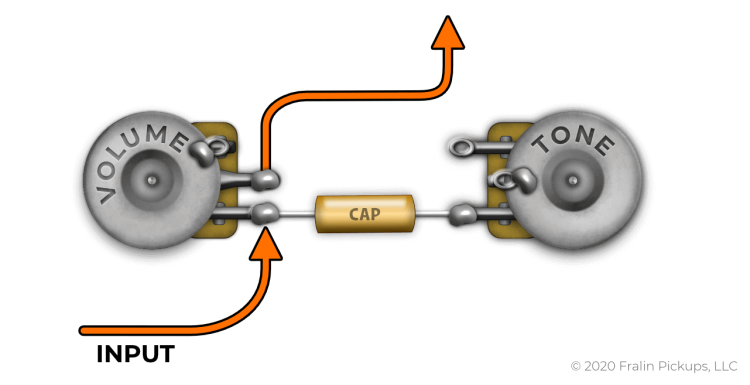
We hope that this article serves as an easy-to-follow reference for anyone trying to wire up their tone pots differently. Experimenting with Tone Cap wiring is an easy way to unlock new tonal possibilities. We have a wide selection of Tone Caps available, so check them out and experiment!
26 Comments For This Post
Want to chime in to the conversation? Please do so! Please respect others.
I have the same question as Jack:
“’60s wiring is almost identical to Modern Wiring, except one can expect a lesser signal to noise ratio.”
Does this mean more noise or less noise? More bad or more good?
Great info, what tone pot to ground arrangement would suit a 1958 Explorer wiring best Thanks
Mark
“’60s wiring is almost identical to Modern Wiring, except one can expect a lesser signal to noise ratio.”
Does this mean more noise or less noise? More bad or more good?
Hello Lindy – Can SSS Stratocasters benefit from 50’s tone pot wiring? If so how would it be wired? Also, can I add a tone bleed circuit to the volume or would that be counter-productive? If it’s a good idea what values would you use for the components? Many thanks – Robert
Interesting. I got two Fralin Dyna P90 to mount in a Gretsch Jet that had Dearmonds in it. So anyhow the 250K pots have to make place for 500’s. It has only one volume and one tone, but the more I read here the more possibilties there are:)
What does grounding the compositor to the 3rd volume lug do for the sound? I have a 1981 Fender bullet that’s wired this way and this way and when I turn the volume all the way down to 0 it cuts the volume off completely. I was just curious if it was wired this way? Or if there’s an issue I should troubleshoot.
What if there’s a treble bleed between lugs 1 and 2 of volume and the tone pot has a capacitor on lug 2 to ground. Where do you connect the tone pot to volume pot?
We recommend linking the tone pot off of the volume pot input lug, so lug 1.
I currently acquired a ES5 switchmaster and the wiring is all messed up and changed and I can’t find any info on original switchmaster pot wiring, any idea what style of wiring they use? It’s from 1957 and the caps are all inside of the shielding can.
Could you wire the 50s style so the cap goes between the vol middle lug and tone middle lug and then ground the tone lug 3 to the back of the pot? Would this reverse the taper of the pot?
Is it possible to wire different caps to different pickups, i.e. a .047 to the bridge pickup and a .022 to the neck pickup? Can the cal be wired to the pickup lead instead of the potentiometer?
You would need separate pots for that job. For instance, you would need a Neck tone pot and a Bridge tone pot.
Remember this is an AC circuit, remember materials are not perfect, they possess material characteristics, like how quickly charge can build up or discharge in the capacitor conductors & dielectrics, Christ, by that amount of delay, the melody has already departed that pitch, so we conclude, the AC applied to materials can dramatically be impacted by internal materials entropy, that which parasitically annihilates from total system energies involved, thus the choice of materials dors in fact play a role in the appeal of the signature
+1 for a description of how the wiring affects tone. I see diagrams with caps wired between pots and caps soldered back to the same pot. There’s never an explanation of why? I’m starting to think tweakers just discovered that sound still came out the amp so left it and then other people copied it. Or there might be other reasons like – ‘it only fits through the f holes if i wire it like that’
I think you might be right on that point!
Great wiring diagrams, but i don’t understand how each one relates to the tone that one hears. Do the wiring changes change the volume ?
A small correction: A guitar tone control is actually a low-pass filter, not a high-pass filter. A high-pass filter passes higher frequencies and sends the lower frequencies to ground. A tone control sends more and more of the high-frequency content to ground as you turn it counter-clockwise.
It’s also worth noting that although “wiring your tone cap in the ’50s style can keep your high frequencies consistent on your pickups while turning down your volume,” you can also accomplish this with a simple treble-bleed mod, without the disadvantage of the ’50s style wiring.
Hey Steve,
Thoughtful answer, but I’m not sure I would agree. While it’s true that a Low Pass filter sends high frequencies to ground and lets low frequencies pass through, a tone cap is doing the opposite, it’s letting high frequencies pass through to ground and rejecting lower frequencies. I used the “Low Pass Filter” analogy for ease of explanation, but I guess it’s a bit confusing! Thanks again,
Tyler
Wow this is really good stuff! Very clear and easy to understand. I agree with a few of the previous folx about descriptions of how the tone and volume pot respond using the different wirings. I get lost in that tine soup so easily lol and have trouble working my way out of it. Thanks again!!
Do you have any info on passive low pass filters? Like the bass contour on reverend guitars?
Nice clear diagrams, but I would have liked a bit more explanation on how the tone circuit responds with the different wiring eg. does ‘60s wiring respond more closely to modern or 50s.
Oddly I found variation 3 ( so called Black Rose wiring from Black Rose Custom Guitars) whilst electrically indentical to v. 1 sounded sweeter on my Les Paul, I did the test “ blind “ with the help of a friend and every time I could hear the difference between v.1 and v.3 ….. unexplainable ?
I have the same questions as Jay (from the previous post).
I just did the ’50s wiring and then the ’50s variation on my telecaster. The results seem identical to me.
The first and third examples of Standard wiring seem really similar to the ’60s wiring; with the middle tone lug grounded and the output tone lug connected to the volume input lug. Is there a tonal difference between those three? I imagine the interaction between the volume and tone knobs would be similar if not the same for those, and the second example of the Standard – with the middle lug connected to volume – would be markedly different. As I understand it there isn’t much difference from placing the cap at different points, it’s more about which lugs are connected, no?
Thanks for all the variations. I have seen so many it is helpful to understand the differences.